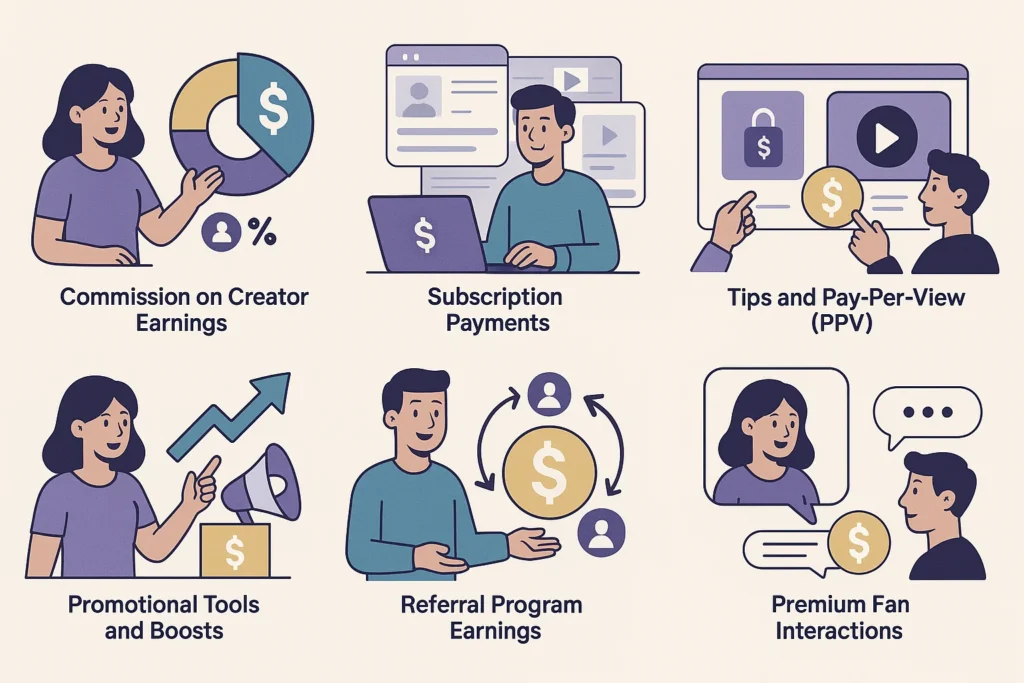Fansly has emerged as a leading content subscription platform, offering creators a monetization model that goes beyond traditional social media. While often compared to OnlyFans, Fansly has carved out its own niche by enabling influencers, adult creators, and digital artists to offer exclusive content directly to paying fans. For startups and SaaS entrepreneurs eyeing this booming creator economy, understanding the revenue model of Fansly provides a gateway to building a sustainable and profitable platform of their own.
In this blog, we’ll explore how Fansly earns money, the key revenue channels it leverages, why this model is thriving in 2025, and how Miracuves can help you replicate a similar monetization engine using a ready-made Fansly clone. Whether you’re looking to launch a creator-first business or enhance your current platform’s earning potential, this breakdown is packed with actionable insights.
How Fansly Makes Money
Fansly follows a creator-first monetization strategy while ensuring a consistent platform revenue stream through multiple sources. Here’s how it generates income:
- Commission on Creator Earnings: Fansly takes a percentage cut from the earnings of every creator on the platform.
- Subscription Payments: Fans pay monthly or yearly fees to access exclusive content from creators.
- Tips and Pay-Per-View (PPV): Fans can send one-time tips or pay to unlock specific premium content.
- Promotional Tools and Boosts: Creators can pay for exposure through boosts, which Fansly charges for.
- Referral Program Earnings: Fansly rewards users who bring in new creators or subscribers, but it still earns from the commissions of referred accounts.
- Premium Fan Interactions: One-on-one messaging and custom requests may carry additional charges, a portion of which goes to Fansly.
These revenue streams collectively ensure that both the platform and its creators benefit while scaling with increased user engagement.

Detailed Breakdown of Revenue Channels
Let’s break down each of Fansly’s income streams to understand how they work, who pays, and why they scale so effectively in today’s creator economy.
1. Commission on Creator Earnings
Fansly takes a 20% commission on all transactions made through the platform — including subscriptions, tips, PPV content, and messaging. This ensures that the platform earns proportionally as its creators grow.
- Who pays: The deduction comes from creators’ earnings.
- Why it scales: As more creators join and increase their subscriber base, Fansly’s passive income from commissions grows without additional overhead.
2. Subscriptions (Monthly and Annual)
Creators set their own subscription price, often ranging from $5 to $50/month. Fansly processes these recurring payments and takes its 20% cut from each transaction.
- Who pays: Fans (subscribers).
- Why it scales: Predictable recurring revenue and low churn due to personalized content offerings.
3. Tips and Pay-Per-View (PPV) Content
Fans can tip creators or unlock specific photos/videos via PPV, often used for highly exclusive or custom content. This one-off payment model adds flexibility beyond subscriptions.
- Who pays: Fans.
- Why it scales: Allows spontaneous purchases and higher monetization during spikes in fan interest.
4. Promotional Boosts and Discovery Features
Fansly allows creators to pay to boost their visibility in search results or featured pages. While not widely publicized, this paid exposure service gives the platform an advertising-based income source.
- Who pays: Creators.
- Why it scales: As competition increases among creators, more are willing to pay for exposure.
5. Referral Program
Fansly encourages users to refer both fans and creators, offering a lifetime commission for successful referrals. While referrers get a percentage, Fansly still profits from its platform cut.
- Who pays: New creators’ earnings are shared, not an out-of-pocket expense.
- Why it scales: Low-cost user acquisition and exponential creator onboarding.
6. Premium Messaging and Custom Content
Fans can pay for exclusive messages, voice notes, or personalized videos. Fansly handles these micro-transactions and keeps its commission.
- Who pays: Fans.
- Why it scales: Deepens fan-creator relationships and enables high-ticket interactions.
This diversified income approach creates a resilient and scalable monetization structure — ideal for platforms operating in the creator economy.
Fansly thrives by offering creators flexible monetization through subscriptions, PPV, tipping, and messaging. Explore its full business model and revenue streams to understand how the platform stacks its earnings.
Why This Revenue Model Works in 2025
The revenue model of Fansly thrives in 2025 due to several converging trends in technology, consumer behavior, and the creator economy. Here’s why it continues to be both relevant and profitable:
1. Rise of the Creator Economy
The global creator economy is valued at over $250 billion and projected to grow rapidly. With millions of independent creators seeking monetization tools, subscription platforms like Fansly meet a growing need for direct fan funding and creative freedom.
- Creators prefer platforms where they control pricing, content, and fan interactions.
- Fans are increasingly willing to pay for personalized, behind-the-scenes, or exclusive content.
2. Subscription Fatigue Is Shifting to Niche Loyalty
Consumers are moving away from broad, impersonal subscriptions and instead supporting niche, high-engagement creators. Fansly’s model enables fans to subscribe to individuals they genuinely connect with.
- Micro-communities are more profitable than large, generic audiences.
- Loyalty-based revenue beats ad-revenue-based models for indie creators.
3. Privacy-First Monetization
As digital privacy becomes more regulated, advertising-based models face challenges. Fansly’s direct-payment model bypasses ad tracking and focuses on value exchange between fans and creators.
- No dependence on third-party ad networks.
- Trust-based platform-user relationship increases retention.
4. Frictionless Payment Infrastructure
Advancements in fintech and global payment gateways have made cross-border micro-transactions easier. Fansly benefits from this by supporting creators and fans across multiple countries.
- Fast payouts and multiple currency options enhance creator satisfaction.
- Subscription renewals and tipping are now seamless with integrated wallets.
5. AI and Personalization Features
With AI, platforms like Fansly can now suggest content, creators, or bundles based on user preferences, boosting engagement and spend per user.
- Dynamic pricing and personalized offers improve revenue per fan.
- AI-assisted moderation improves compliance without extra manpower.
All these factors support a scalable, creator-friendly, and future-proof monetization engine — one that’s ideal for replication by new startups entering the space.
Fansly attracts creators with features like tiered subscriptions, PPV, and direct messaging, making it a true content magnet. Discover the complete Fansly app features list and see why startups prefer our Fansly clone over custom development for faster, cost-efficient launches.
Can Startups Replicate Fansly’s Revenue Model?
Absolutely — but with a few caveats. While the revenue model of Fansly is proven and scalable, replicating it from scratch requires significant time, technical know-how, and financial investment. Building a robust subscription platform that supports secure payments, content management, user privacy, referral systems, and global scalability is a complex task.
Challenges of Building from Scratch
- Development Complexity: A full-featured content platform requires backend scalability, media protection, payment integration, and creator dashboards.
- Compliance & Moderation: Handling adult or exclusive content demands strict policy adherence, age verification systems, and legal safeguards.
- Time-to-Market: Building a custom solution can take 12–18 months, causing missed market opportunities in a fast-moving space.
- Monetization Delay: Without a ready-made infrastructure, it’s hard to activate monetization early, limiting cash flow for new founders.
How Miracuves Helps You Launch a Fansly-Like Platform
Miracuves offers a fully customizable Fansly clone that mirrors the monetization engine of the original — complete with subscription models, tipping, premium messaging, referral systems, and revenue analytics.
- Faster Launch: Go live in weeks, not years.
- Custom Features: Add or remove monetization elements based on your niche or audience.
- Scalable Architecture: Built to support growth without overhauls.
- Affordable Pricing: Lower upfront cost compared to custom development.
Whether you’re targeting fitness influencers, adult creators, or niche educators, Miracuves gives you the power to replicate Fansly’s revenue model with your own brand and vision.
The Fansly Clone by Miracuves is priced at $2,899, providing a fully customizable creator-subscription platform — ready to go live within 3 days for a complete launch experience.
Kickstart your platform with the best Fansly clone scripts in 2025, learn to scale using our Fansly developer guide for JavaScript & PHP, and grow fast with a proven Fansly marketing strategy.
Conclusion
Fansly’s revenue model stands out as a modern blueprint for monetizing the creator economy. With multiple income sources — from subscriptions and tips to PPV content and referral programs — it creates value for both the platform and its users. Its success in 2025 is driven by creator empowerment, direct-to-fan monetization, and smart use of digital infrastructure.
For startups and digital entrepreneurs, replicating this model isn’t just possible — it’s profitable when approached with the right tools. Miracuves offers a ready-to-launch Fansly clone that captures the essence of Fansly’s monetization strategy while giving you full control and customization.
FAQs
How does Fansly generate revenue?
Fansly earns money by taking a 20% commission on creator earnings from subscriptions, tips, PPV content, and premium interactions. It also monetizes via creator-paid promotional boosts and referral commissions.
Is Fansly profitable in 2025?
While private, Fansly is widely considered profitable in 2025 due to its recurring revenue streams, high user engagement, and growing creator base fueled by the subscription economy.
What are the main income sources for Fansly?
Fansly’s income sources include subscription fees, one-time tips, pay-per-view content, promotional boosts, and referral commissions. The platform retains a 20% cut from all transactions.
Can startups use the same revenue model as Fansly?
Yes, startups can adopt Fansly’s monetization strategy, but building such a platform from scratch requires time and capital. A clone solution like Miracuves speeds up the process and reduces costs.
Does Miracuves offer a Fansly clone with monetization features?
Yes. Miracuves provides a ready-made Fansly clone that includes all key monetization channels — subscriptions, tips, premium messaging, referrals — with full customization options for scaling.
Related Articles :-








